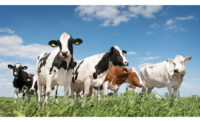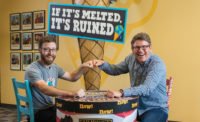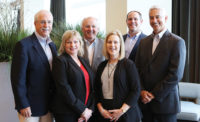
Mission Possible
by Pamela Accetta Smith
Joseph Gallo Farms continues to break the mold at its California-based cheese processing plant.
Some experts
say success tied to vertical integration is more the exception than the
rule — a concept that doesn’t work for everyone. But for Joseph
Gallo Farms, this concept lies at the heart of its success, and work it
does.
The company’s ongoing commitment to
environmental responsibility, coupled with innovative practices and
effective public outreach, puts this California cheese operation at the
head of the pack.
“Producing top-quality products while ensuring
environmental accountability is our mission,” says Carl Morris,
general manager and chief operating officer.
Stretching over nearly 15,000 acres, Joseph Gallo
Farms comprises five dairies near Atwater, Calif., all within 10 miles of
each other. Together, they manage over 15,000 cows. The company’s
cheese plant provides a ready market for the 300 million pounds of milk the
dairies produce each year. Joseph Gallo Farms is one of the nation’s
largest dairy farm operations, with more than 450 employees.
Joseph Gallo Farms is located next to the largest
concentration of wetlands left in California, the San Joaquin Valley
Grasslands. These wetlands are home to a wide variety of migrating
wildlife, including geese, ducks, cranes, egrets, hawks and bald eagles.
Starting in the early 1990s, the company sold several
thousand acres to the U.S. Fish and Wildlife Service; this land became part
of the San Luis National Wildlife Refuge Complex. Joseph Gallo Farms
partnered with the Fish and Wildlife Service again in 1995, placing more
than 2,000 acres into an agricultural conservation easement program. It was
the first California farm to do so.
Mike Gallo, chief executive officer and co-owner,
supports the call for government incentives to help dairy farmers adopt
sustainable production practices. “Most dairy farmers would not be
able to make these improvements without incentives,” he says.
Ten years ago, Gallo created a department of
environmental affairs at his company, formally making conservation
management a key business function. By taking a proactive approach, he has
helped the company avoid regulatory problems, improve the public’s
perception of California dairies and enhance brand recognition of the
company’s premier product, Joseph Farms cheese.
The farm’s environmental commitment extends
beyond the local wildlife. In 2004, the farm adopted a comprehensive
nutrient management plan for all five dairies. It also added a methane
digester at the company’s Cottonwood Dairy to convert manure into
electricity.
“This technology has terrific potential to
reduce reliance on foreign energy sources,” Morris says. “Not
many cheese plants make their own energy out of their waste.”
Those who operate Joseph Gallo Farms say the payoff
for the digester — because of the added savings in the cheese
processing — will be three or four years. It’s expected to save
$500,000 a year in electrical costs.
The Processing End
Stretching some 120,000 square feet, the plant
produces about 30 million pounds of cheese per year. It processes cheddar
(mild, medium, sharp and extra sharp), Monterey jack, pepper jack, marble
jack, marble cheddar, mozzarella, colby, longhorn and muenster (other
varieties, including Joseph Farms-branded Swiss, American and provolone,
are co-packed). All varieties are packaged in a range of sizes and styles
— chunks of all sizes, shreds and slices, plus balls for the
company’s mozzarella. The facility also produces and sells whey
protein isolate through a joint venture with Saputo in 20-kilogram bags as
a food ingredient.
In operation since 1982, the cheese plant receives
milk daily, piped over directly from the company’s Cottonwood Dairy.
“The milk is piped from the tanks at the dairy and into the silos at
the plant,” Morris says. “From the other dairies, milk is
trucked in. We have five dairies, but Cottonwood is the largest with 5,000
cows. The other four are located in various locations of the
ranch.”
Cheese production at the plant begins with the arrival
of the milk. Once received, the raw product undergoes a series of quality
tests before being stored in silos prior to processing. The milk travels
from the silos, runs through a separator to skim cream as needed for the
cheese, then flows through to the pasteurizers and out to the cheesemaking
vats. The type of cheese begins with the cultures added to the milk; the
starter cultures are added to begin the process, then rennet is added to
make the curds.
After the vat-forming process, plastic-sealed cheese
blocks are placed in cardboard boxes and head off to the refrigerated aging
room. When they emerge from aging, the blocks are unwrapped and fed into
cutters, which trim them down into various marketed sizes. Operators
carefully monitor the cutters to reduce trim, which goes into the
plant’s shred line.
Meanwhile, cut blocks are weighed and sorted;
correct-weighing blocks head down the middle of a conveyor belt for
wrapping, while others are kicked aside and either adjusted or profiled
down for different packaging. Blocks travel to the sealing chamber, then
through metal detection, followed by code-dating and boxing for cold
storage and their eventual journey to market.
For mozzarella, after separation, the curd is cooked,
stretched and molded into mozzarella balls, then dropped into a brine bin
for cooling.
Whey, the byproduct of cheesemaking, undergoes a
process of its own. Liquid whey is processed through a series of
membranes, then dried to produce high-quality whey protein isolate.
Quality Matters
With its complete vertical integration, from managing
its own feed-cropping acreage and livestock herds, through milking and
cheesemaking operations, Joseph Gallo Farms offers 100 percent assurance of
every product’s purity.
Morris says cheese can be “finicky”
— variations in seasons, weather, milk components, cultures and
enzymes can all affect the quality of the cheese produced. “Our
vertical integration gives us a high level of control over all of
this,” he says. “Plus, skilled, trained cheesemakers are
necessary to produce consistent, quality product all the time. Our
commitment to quality from all our employees is critical to producing
products that our customers and consumers want and need.”
Respected veterinarians have estimated that 95 percent
of all dairies use some type of artificial hormones — including, but
not limited to, reproduction hormones, milk-letdown hormones,
growth-promoting hormones, vaccine or shock-reaction hormones, or steroid
anti-inflationary hormones. Joseph Gallo Farms is the longest-standing
cheese producer nationwide to be granted government approval to label its
products with “No Artificial Hormones.”
Likewise, most of the cheeses produced by Joseph Gallo
Farms are now certified kosher, adding yet another quality distinction to
its line of fine cheeses. In fact, a rabbi can be seen walking the grounds
and plant to ensure that every step of the way follows the strict
guidelines of OK Kosher Certification.
The company has systems in place that monitor every
step of the cheesemaking process, from HACCP and safety programs, to
auditing programs in house for suppliers.
“As part of our HACCP program, we have
procedures in place for qualifying new suppliers, especially of
ingredients, food contact materials and purchased cheese,” Morris
says.
“Our HACCP plan is certified by the IDFA. Also,
we are a USDA-inspected plant, and our dairies are all Grade A. Various
federal and state inspections are made regularly. Also, customers
frequently require independent audits. But the most important part of our
quality program is making every employee aware of and committed to quality,
throughout the production.”
Technological Impact
Gene Goetsch, cheese plant manager, says the company
has continuously expanded and improved its facilities over the years.
“Most recently, in 2006, we completed a new 33,000-square-foot
packaging facility to improve the efficiency and quality of our packaging
operations and to give us room for growth,” he says. “On the
horizon are various equipment additions to improve efficiencies, and
possible cheese line additions in the new available space in our main
cheese plant.”
In terms of in-plant processes considered most
innovative, Morris says, the company’s whey protein operation is one
that is ahead of the game. “Our whey protein operation is very
innovative — only a few plants make this purity of whey protein
powder,” he says.
The plant’s new state-of-the-art packaging
machine has also improved efficiencies, Morris says. “Our new
packaging building has embraced enhanced efficiencies and quality
consistency,” he says. “In addition, it paves the way
for further efficiency improvements.”
In terms of future capital expenditures earmarked for
improving manufacturing efficiencies, Morris says the company is
considering several possibilities, but nothing definite at this time.
“In general, these include efficiency-increasing equipment
installations, expanding cheese production capacity and producing
additional cheese varieties,” he says.
Admittedly, some plant operations are more automated
than others, Goetsch says, “but we wanted to keep the art of
cheesemaking in the process.”
Environmental Advantage:The Methane Digester
System at Joseph Gallo Farms
Joseph Gallo Farms
completed construction of a large-scale methane digestion and power
generation system in 2004. This innovative project was funded in part by a
grant from the California Energy Commission through Western United Resource
Development.
At the heart of the system is a 7-acre covered lagoon
digester. Flushed manure from the company’s Cottonwood Dairy is
pumped to this lagoon, where natural microbial action converts the
nutrients in the manure into methane. A custom-engineered high-density
polyethylene cover over the lagoon captures this biogas and channels it
into a pipeline, where it is transported to the company’s cheese
plant.
The gas is first cleaned and treated, and then used to
fuel two generators operating around the clock which produce a total of 700 kilowatts of electricity.
This provides most of the electrical requirements of the cheese plant. The
heat from the generator engines and exhaust systems is captured and used to
produce steam for the cheese plant, which saves about 200,000 gallons of
propane per year. The company, an award-winning leader in environmentally
compatible farming, is especially proud of the many environmental benefits
of the methane digester system.
Facts and Stats:
Cows at Cottonwood Dairy: About
5,000.
Milk processed at cheese plant: 900,000 pounds per day.
Elapsed time from project approval to completion: Two years, one month.
Gallons of manure flushwater handled per day: 1,300,000 gallons.
Height of separators: 50 feet.
Capacity of digester lagoon: 44,225,000 gallons.
Capacity of overflow lagoon: 94,464,000 gallons.
Area of digester cover: 7 acres.
Digester cover material: 60 mil HDPE.
Volume of biogas used in generators each day: 290,000 cubic feet.
Distance of biogas pipeline from digester to generator: 4,750 feet.
Generator electrical production: 700 kilowatts.
Electricity produced each year: About 5,200,000 kilowatt hours.
Dollar savings from self-generation of electricity and steam: About $2,300 per day.
Milk processed at cheese plant: 900,000 pounds per day.
Elapsed time from project approval to completion: Two years, one month.
Gallons of manure flushwater handled per day: 1,300,000 gallons.
Height of separators: 50 feet.
Capacity of digester lagoon: 44,225,000 gallons.
Capacity of overflow lagoon: 94,464,000 gallons.
Area of digester cover: 7 acres.
Digester cover material: 60 mil HDPE.
Volume of biogas used in generators each day: 290,000 cubic feet.
Distance of biogas pipeline from digester to generator: 4,750 feet.
Generator electrical production: 700 kilowatts.
Electricity produced each year: About 5,200,000 kilowatt hours.
Dollar savings from self-generation of electricity and steam: About $2,300 per day.
Powerful Influence
Pacific Gas and Electric Co. teamed up with Joseph
Gallo Farms and Microgy Inc. to provide clean, renewable manure digester
biogas to power California Gov. Arnold Schwarzenegger’s
“Leading the Green Dream” Inaugural Celebration on the south
steps of the State Capitol in January. PG&E also used biodiesel made
from soybean oil, solar energy and purchasing carbon credits to make the
event’s power use carbon neutral.
The greenhouse gasses typically emitted from the
conventional resources normally used to power events like this have been
cut in half by using these renewable energy sources. PG&E is also
purchasing carbon dioxide reductions from the Van Eck Forest in Humboldt
County, which is the first forest certified by California’s stringent
forest sequestration protocols, to make all the energy used to power this
event carbon neutral.
The biogas for a 60-kilowatt generator that helped
power the celebration was created from cow manure at Joseph Gallo Farms in
Atwater, Calif. The biogas process uses natural microbial action to convert
the nutrients in the manure into a renewable energy source. Using the gas
to create electricity also reduces greenhouse gas emissions.
“My family and I have had a strong
commitment to the California environment for generations now. I am
pleased that our governor shares this emphasis with us, and am happy to
work with him to help keep our state great,” says Mike Gallo, chief
executive officer of Joseph Gallo Farms.
PG&E first contacted Gallo just before Christmas
about obtaining biogas to power the inauguration.
JOSEPH GALLO FARMS
PLANT AT A GLANCE
Plant size: About 120,000
square feet.
Number of employees: About 180 in cheese plant (450 total company).
Shifts: 2.5 for production/ 1.5 for packaging.
Product volume/capacity: 30 million pounds of cheese per year.
Product mix:
•About 250 SKUs.
•Basic products include natural cheeses — primarily cheddar (mild, medium, sharp and extra sharp), Monterey jack, pepper jack, marble jack, marble cheddar, mozzarella, Colby, longhorn and Muenster.
•Swiss, American, Provolone and some other varieties made by co-packers.
•All varieties are packaged in a range of sizes and styles — chunks of all sizes, shreds, slices and mozzarella balls.
•The company also produces and sells whey protein isolate in 20-killogram bags as a food ingredient.
Processing lines: Cheese towers, mozzarella, 6 packaging lines, longhorns, muenster, WPI.
$OMN_arttitle="Mission Possible";?>
$OMN_artauthor="Pamela Accetta Smith";?>Number of employees: About 180 in cheese plant (450 total company).
Shifts: 2.5 for production/ 1.5 for packaging.
Product volume/capacity: 30 million pounds of cheese per year.
Product mix:
•About 250 SKUs.
•Basic products include natural cheeses — primarily cheddar (mild, medium, sharp and extra sharp), Monterey jack, pepper jack, marble jack, marble cheddar, mozzarella, Colby, longhorn and Muenster.
•Swiss, American, Provolone and some other varieties made by co-packers.
•All varieties are packaged in a range of sizes and styles — chunks of all sizes, shreds, slices and mozzarella balls.
•The company also produces and sells whey protein isolate in 20-killogram bags as a food ingredient.
Processing lines: Cheese towers, mozzarella, 6 packaging lines, longhorns, muenster, WPI.





